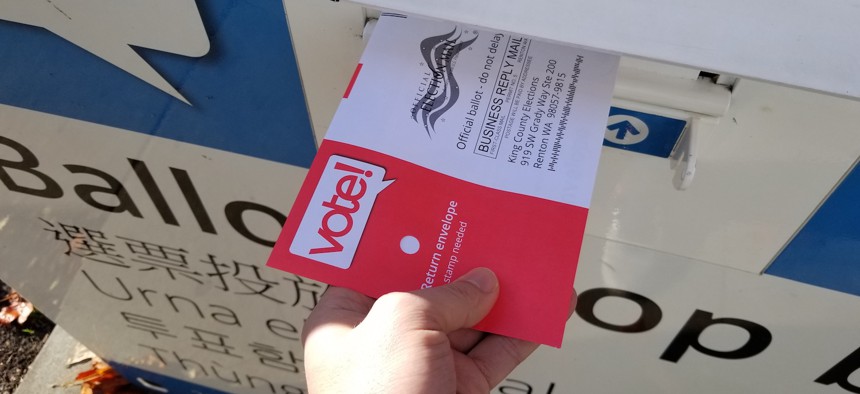There’s an Easy and Effective Way to Boost Voter Participation

Returning a ballot at a King County Elections drop-off bin outside the Ballard branch of the Seattle Public Library. Michael Grass / Route Fifty
And this low-tech solution has been around for two decades.
SEATTLE — State and local officials across the nation have been reporting surges in early voting ahead of Tuesday’s midterm elections, signs of an incredibly engaged electorate. When all is said and done, previous voter participation records for mid-term elections in many parts of the nation are very likely to fall despite the hoops some officials make voters jump through to participate in American democracy.
In the U.S., elections administration is a complicated patchwork quilt of state and local registration requirements and rules over access to early voting. There are places where the act of voting has become incredibly politicized, like in Georgia and North Carolina. And then there are places where it’s not.
But for those states that have sometimes baffling and befuddling requirements, there’s a simple and proven way to make voting far less bureaucratic that’s been successfully used for nearly two decades—voting by mail or by dropping off ballots at designated collection points.
It’s been 20 years since Oregon voters approved Measure 60, a statewide ballot initiative that authorized the state to move toward a mail-in voting system, one that not only eliminates traditional brick-and-mortar polling sites and the need to staff them but has been shown to increase participation.
NBC News recently interviewed Oregon’s current secretary of state, Republican Dennis Richardson, and his Democratic predecessor, Phil Keisling, about the successes of voting the “Oregon way,” highlighting its bipartisan appeal and security advantages.
"You can't hack paper," said Richardson.
"Isn't that amazing in its simplicity?" said Keisling. "Give everyone their ballot and then let them decide where they want to mark it, whether they want to mark it at all."
Not surprisingly, Oregon ranks No. 1 in the ease of voting in Northern Illinois University’s “Cost of Voting Index,” which was released in September and examines “the time and effort it took to vote in each presidential election year from 1996 through 2016” for each of the 50 states.

Washington state, like Oregon, eschews traditional brick-and-mortar voting locations and allows residents to mail-in and drop-off their ballots.
This Seattle-based Route Fifty correspondent can attest to the simplicity of this voting process: The ballot arrives in the mail a few weeks ahead of Election Day; then you can sit with an election guide featuring candidate statements and details of state and local ballot initiatives and make your choices at your own pace; and then you head over to a ballot drop-off point before the voting deadline. And for those who don’t want to be inconvenienced with the act of leaving home to vote, King County, which includes Seattle, is now covering the cost of postage for those mailing in their ballots.
The vote-at-home approach to casting ballots has been slowly expanding across the U.S. through various pilot projects at the state and local level. Beyond Oregon and Washington, Colorado launched vote-at-home balloting statewide in 2014, but interest has been growing in various parts of the nation.
Nebraska has given the green light to more of its rural counties, where election administration can be costly, to use an all mail-in voting system.
California aims to have 100 percent of its counties using the vote-at-home system by 2022. According to CALmatters, voters in five counties—Madera, Napa, Nevada, Sacramento and San Mateo—can mail in or drop off their ballots for the 2018 midterm elections, as authorized in the state’s Voter’s Choice Act.
For the August primary elections in King County, Washington—the first where the county covered the costs of postage for mail-in ballots—local officials had projected a 40 percent turnout rate. The actual turnout was 43.3 percent, the highest voter participation rate in a King County primary election since 2004. The county has also expanded the number of ballot drop-off locations in an effort to boost access even more.
As of last week Wednesday, approximately 411,000 ballots in King County had been returned by mail or at a drop-off location. “For comparison, there were about 420,000 ballots returned at this point in the 2016 General Election,” King County Elections tweeted.
RELATED on Route Fifty:
Michael Grass is Executive Editor of Government Executive’s Route Fifty and is based in Seattle.
NEXT STORY: No Breathalyzer for the Stoned? Maybe That’s OK.






